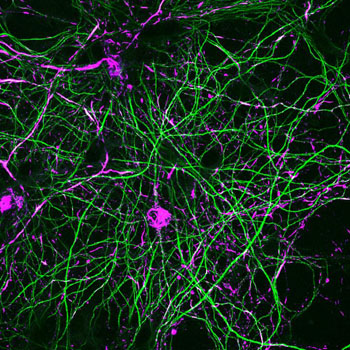Inhibitors of a Mutant Kinase May Be Potential Treatment for Parkinson's Disease
By LabMedica International staff writers
Posted on 01 Aug 2016
A potential therapeutic approach for treatment of Parkinson's disease is based on drugs that block the activity of a mutated version of the enzyme LRRK2 (Leucine-rich repeat kinase 2). Posted on 01 Aug 2016
The Gly2019S mutation is one of a small number of LRRK2 mutations proven to cause Parkinson's disease. Of these, Gly2019S is the most common in the Western World, accounting for about 2% of all Parkinson's disease cases in North American Caucasians. This mutation is enriched in certain populations, being found in approximately 20% of all Ashkenazi Jewish Parkinson's disease patients and in approximately 40% of all Parkinson's disease patients of North African Berber Arab ancestry.

Image: Primary hippocampal neurons from mice expressing G2019S-LRRK2. The neurons were treated with alpha-synuclein fibrils, and 18 days later immunofluorescence was performed. The magenta shows phospho-alpha-synuclein inclusions in the cell bodies and throughout the axons, which are visualized as green (Photo courtesy of the University of Alabama).
Pathologic inclusions characterize the class of alpha-synucleinopathies that include Parkinson's disease. However, the interaction between alpha-synuclein, LRRK2, and the formation of alpha-synuclein inclusions remains unclear.
To study these molecular interactions, investigators at the University of Alabama (Birmingham, USA) applied very low concentrations of pre-formed fibrils of alpha-synuclein to in vitro or in vivo neurons. This caused formation of modified alpha-synuclein inclusions that shared morphology with those found in the brains of Parkinson's disease patients after death. The investigators used this model system to test the effects of neuron expression of the mutant G2019S form of the LRRK2 enzyme on the formation of the inclusion pathology.
They reported in the July 13, 2016, issue of the Journal of Neuroscience that G2019S-LRRK2 expression, in both cultured neurons and dopaminergic neurons in the substantia nigra pars compacta region of the rat brain, increased the recruitment of endogenous alpha-synuclein into inclusions in response to alpha-synuclein fibril exposure. Potent LRRK2 kinase inhibitors, which are being developed for clinical use, blocked the increased alpha-synuclein aggregation in G2019S-LRRK2-expressing neurons.
The results obtained during this study demonstrated that alpha-synuclein inclusion formation in neurons could be blocked and that novel therapeutic compounds, which target this process by inhibiting LRRK2 kinase activity, may slow progression of Parkinson's disease-associated pathology.
"These data give us hope for the clinical potential of LRRK2 kinase inhibitors as effective therapies for Parkinson's disease," said first author Dr. Laura A. Volpicelli-Daley, assistant professor of neurology at the University of Alabama. "The LRRK2 kinase inhibitors may inhibit the spread of pathologic alpha-synuclein, not only in patients with LRRK2 mutations, but in all Parkinson's disease patients. Future studies to validate the safety and efficacy of the LRRK2 inhibitors will be necessary before testing the inhibitors in human clinical trials."
Related Links:
University of Alabama













